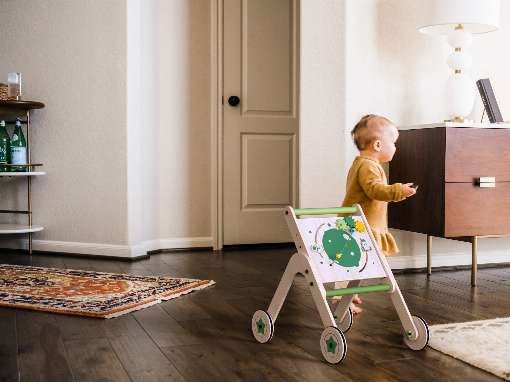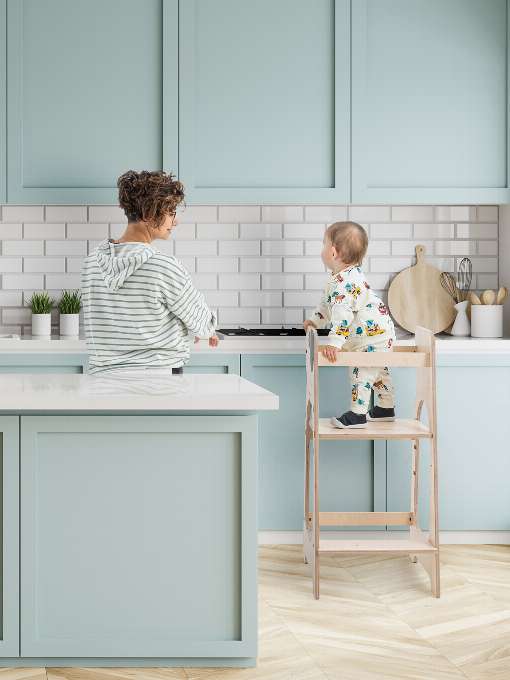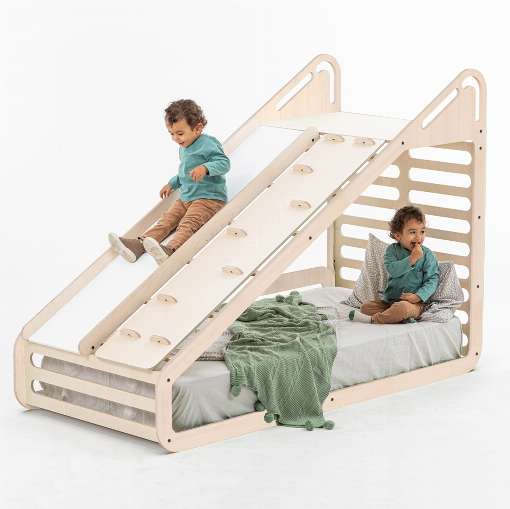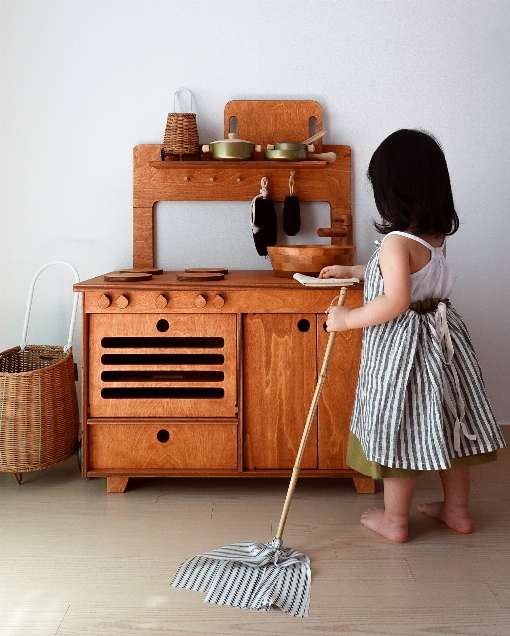10.10.2023
Children and youth furniture:
Bonn. Almost 12 million children up to the age of 15 live in Germany's households, making up around 14 percent of the population. Worldwide, their share is as high as around 30 percent. On average, children in Germany occupy a room with an area of 10 square meters. A bed and wardrobe, as well as a table and chair, are among the basic furnishings for young children. In addition to the functions of sleeping and storage space, toys and decorations are also included. Parents and guardians always pay attention to the issue of safety, especially when buying children's furniture. Stability, tilt resistance, crush resistance, etc. are decisive for the purchase decision. In addition, the material as a quality feature moves into the focus of the clientele. Parents, single parents and other guardians are attaching more and more importance to ecological materials that are sustainable.
Three trends were conspicuous at the "Kind- und Jugend" international trade fair held in Cologne at the beginning of September: pastel shades predominate in the colors offered by furniture manufacturers and other goods. In terms of design language, the products appear restrained, clear and modest, and finally, the original functions are always about expansion and added value. All three trends demonstrate the desire of industry and customers to focus more on durability and also on recycling in the sense of the circular economy. Restrained colors and natural materials such as wood or plywood are durable and not subject to short-term fads. A clear and "unchildlike" design allows children's furniture to be used for other purposes later on, for example, when a small closet becomes a tool or shoe cabinet. Bed frames can be converted into climbing frames and the wooden attachment for the canopy bed can later serve as a sunshade on the balcony.
Products made of honest and sustainable materials are getting more and more attention in the market. A variety of plywood furniture is conspicuous. Plywoods consist of several layers of wood veneer, which are glued together alternately in such a way that an extremely stable, but also bendable board is created. Thus, even round shapes, such as bowls or arches can be formed from plywood, which is why they are used as an alternative to particleboard or MDF for ecological and visual reasons. Plywood is robust and almost "indestructible". And if children's furniture can be used for other purposes and functions after its actual use phase, a responsible and prudent decision has been made.
"The industry is not afraid of the desire to reuse and upcycle. There will be services along an interconnected value chain that will activate it for itself. Digitization will drive and expand packaging, transportation, systematic material recycling, and other service offerings. That's why the mood in the children's and young people's furnishings sector is confident," says Ursula Geismann, Managing Director of Initiative Furnier + Natur (IFN) and a trend analyst of many years' standing, explaining the trade show's optimism. IFN/DS
Initiative Veneer + Nature (IFN) The Initiative Furnier + Natur (IFN) e.V. was founded in 1996 by the German veneer industry and its partners. Today it is supported by European companies from the veneer industry, the trade and the veneer processing industry as well as trade associations of the wood industry. The aim of the association is to promote veneer as a natural all-round material.
Further information at:
furnier.de
www.furniergeschichten.de
facebook
linkedin
instagram
Images 1 to 3: Children's furniture made of plywood: sustainable and beautiful. Photo: Mamatoyz, Turkey
Photo 4: Mini kitchen made of veneer plywood. Photo: MIDMINI - Plywood Furniture, Latvia.
October 10, 2023
Children and youth furniture:
The children's room becomes a sustainable oasis of well-being
Bonn. Almost 12 million children up to the age of 15 live in Germany's households, making up around 14 percent of the population. Worldwide, their share is as high as around 30 percent. On average, children in Germany occupy a room with an area of 10 square meters. A bed and wardrobe, as well as a table and chair, are among the basic furnishings for young children. In addition to the functions of sleeping and storage space, toys and decorations are also included. Parents and guardians always pay attention to the issue of safety, especially when buying children's furniture. Stability, tilt resistance, crush resistance, etc. are decisive for the purchase decision. In addition, the material as a quality feature moves into the focus of the clientele. Parents, single parents and other guardians are attaching more and more importance to ecological materials that are sustainable.
Three trends were conspicuous at the "Kind- und Jugend" international trade fair held in Cologne at the beginning of September: pastel shades predominate in the colors offered by furniture manufacturers and other goods. In terms of design language, the products appear restrained, clear and modest, and finally, the original functions are always about expansion and added value. All three trends demonstrate the desire of industry and customers to focus more on durability and also on recycling in the sense of the circular economy. Restrained colors and natural materials such as wood or plywood are durable and not subject to short-term fads. A clear and "unchildlike" design allows children's furniture to be used for other purposes later on, for example, when a small closet becomes a tool or shoe cabinet. Bed frames can be converted into climbing frames and the wooden attachment for the canopy bed can later serve as a sunshade on the balcony.
Products made of honest and sustainable materials are getting more and more attention in the market. A variety of plywood furniture is conspicuous. Plywoods consist of several layers of wood veneer, which are glued together alternately in such a way that an extremely stable, but also bendable board is created. Thus, even round shapes, such as bowls or arches can be formed from plywood, which is why they are used as an alternative to particleboard or MDF for ecological and visual reasons. Plywood is robust and almost "indestructible". And if children's furniture can be used for other purposes and functions after its actual use phase, a responsible and prudent decision has been made.
"The industry is not afraid of the desire to reuse and upcycle. There will be services along an interconnected value chain that will activate it for itself. Digitization will drive and expand packaging, transportation, systematic material recycling, and other service offerings. That's why the mood in the children's and young people's furnishings sector is confident," says Ursula Geismann, Managing Director of Initiative Furnier + Natur (IFN) and a trend analyst of many years' standing, explaining the trade show's optimism. IFN/DS
Initiative Veneer + Nature (IFN) The Initiative Furnier + Natur (IFN) e.V. was founded in 1996 by the German veneer industry and its partners. Today it is supported by European companies from the veneer industry, the trade and the veneer processing industry as well as trade associations of the wood industry. The aim of the association is to promote veneer as a natural all-round material.
Further information at:
furnier.de
www.furniergeschichten.de
Images 1 to 3: Children's furniture made of plywood: sustainable and beautiful. Photo: Mamatoyz, Turkey
Photo 4: Mini kitchen made of veneer plywood. Photo: MIDMINI - Plywood Furniture, Latvia.
October 10, 2023



